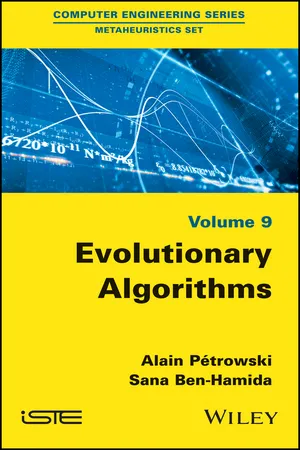
- English
- ePUB (mobile friendly)
- Available on iOS & Android
Evolutionary Algorithms
About This Book
Evolutionary algorithms are bio-inspired algorithms based on Darwin's theory of evolution. They are expected to provide non-optimal but good quality solutions to problems whose resolution is impracticable by exact methods.
In six chapters, this book presents the essential knowledge required to efficiently implement evolutionary algorithms.
Chapter 1 describes a generic evolutionary algorithm as well as the basic operators that compose it. Chapter 2 is devoted to the solving of continuous optimization problems, without constraint. Three leading approaches are described and compared on a set of test functions. Chapter 3 considers continuous optimization problems with constraints. Various approaches suitable for evolutionary methods are presented. Chapter 4 is related to combinatorial optimization. It provides a catalog of variation operators to deal with order-based problems. Chapter 5 introduces the basic notions required to understand the issue of multi-objective optimization and a variety of approaches for its application. Finally, Chapter 6 describes different approaches of genetic programming able to evolve computer programs in the context of machine learning.
Frequently asked questions
Information
1
Evolutionary Algorithms
1.1. From natural evolution to engineering
- – the variations of individual characteristics between parents and offspring;
- – the heritability of much of these characteristics;
- – a competition that selects the fittest individuals of a population in relation to their environment, in order to survive and reproduce.
- – the evolution strategies (ESs) of H. P. Schwefel and I. Rechenberg [REC 65, BEY 01], which are derived from an experimental optimization method to solve fluid dynamics problems;
- – the evolutionary programming (EP) of L. J. Fogel et al. [FOG 66] which aimed, in the mid-1960s, to evolve the structure of finite-state automata with iterated selections and mutations; it was desired to be an alternative to artificial intelligence at the time;
- – Genetic algorithms (GAs) were presented in 1975 by J.H. Holland [HOL 92], with the objective of understanding the underlying mechanisms of systems able to self-adapt to their environment.
Table of contents
- Cover
- Title
- Copyright
- Preface
- 1 Evolutionary Algorithms
- 2 Continuous Optimization
- 3 Constrained Continuous Evolutionary Optimization
- 4 Combinatorial Optimization
- 5 Multi-objective Optimization
- 6 Genetic Programming for Machine Learning
- Bibliography
- Index
- End User License Agreement